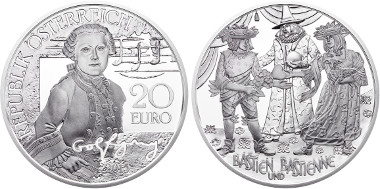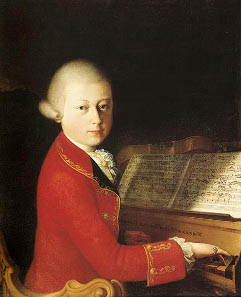August 13, 2015 – The Austrian Mint will issue a new silver coin to begin a set of 3 silver coins entitled “Wolfgang Amadeus Mozart, A Life in Three Acts”, celebrating the musical genius of Wolfgang Amadeus Mozart. His name, arguably, makes up the three most famous words in musical history.
Austria / 2015 / 20 Euros / Silver .900 / 20 g / 34 mm / Designers: Helmut Andexlinger and Thomas Pesendorfer / Mintage: 50,000.
The obverse of the coin depicts a forward facing young Mozart dressed in formal attire, which he was often seen wearing while performing for numerous European royal courts. The engraver has captured the details of his lace cuff and neckline very clearly. The first name of Mozart’s three-part signature is mirrored along the lower portion of the design. This side of the coin was designed and engraved by Austrian Mint engraver Helmut Andexlinger and also bears the face value of 20 euros and the country of issue, “Republik Österreich”, the Republic of Austria, as well as the year of issue, 2015.
The reverse of the coin depicts the opera “Bastien und Bastienne,” a light-hearted comic one-act opera. This side depicts the reunion of Bastien and his girl Bastienne by a spell chanted by the magician depicted in the center. The fine details of the design painstakingly capture the rich details of the sorcerer’s cloak as well as the elaborate costumes of the two young people. Even the curly fur of the lamb carried by Bastienne, in the croak of her left arm, has been carefully captured by the mint’s chief engraver Thomas Pesendorfer.
Mozart, the young prodigy, wrote this opera at the tender age of 12 in 1768. The story of the opera is a story of the young girl Bastienne who becomes unsure when her good friend Bastien begins to admire another young lady. Bastienne speaks with the village sorcerer who advises her to give Bastien a cold shoulder and be distant. Bastien is shocked when he comes back to the stage and the sorcerer states that Bastienne has a new friend. Bastien sings about his love for Bastienne. The magician seizes the opportunity and speaks a nonsensical spell. However, Bastienne decides to continue the ruse a bit longer until Bastien threatens to commit suicide. The two decide that this has gone on long enough and come back together.
Mozart’s understanding of human behavior and the ability to exaggerate for comic effect was well developed, especially for a preteen – a skill that becomes apparent in some of his later works as well.
Wolfgang Amadeus Mozart (aged 14) in Verona, painting by Saverio dalla Rosa, 1770.
Mozart was born in Salzburg on January 27, 1756. He was christened Johannes Chrysostomus Wolfgangus Theophilus. Since his birthday, January 27, is also the Catholic feast day for St. John Chrysostom, this was a given to be part of his Christian name. Mozart liked to call himself Wolfgang Amadé or Amadeus. He was multilingual and therefore adapted his name throughout his lifetime.
Mozart was as boisterous and playful as the Rococo period during which he was born. His father, Leopold, was a composer himself and taught his children, Maria Anna (aka Nannerl) and Wolfgang, music. Maria Anna at the age of seven, five years older than Wolfgang, was learning to play piano from her father with Wolfgang looking on. It was not long before Wolfgang mimicked her at the keyboard. His first public performance was at the age of six at the Bavarian court in Munich alongside his older sister.
The skill and ability of the musical prodigy was recognized early and his father gave up his own composing life to focus on the general education of his children and especially on the musical talents of his son. They toured and performed at the royal courts of London, The Hague, Munich, Paris and Zurich. Each member of the family fell life-threateningly ill while on tour but that did not prevent the young Mozart from completing three operas by the age of 12.
When his sister Nannerl was 18 and Wolfgang 13, she stopped performing publically as was the social custom of the time. Wolfgang continued touring with his father alongside. They met such well-known composers of the time as Bach and Haydn. After a falling out with his benefactor in Salzburg, he moved to Vienna, where he met and then married Constanze Weber. They followed an extravagant lifestyle, living in the most exclusive apartment in Vienna and wearing elaborate clothing, both of which Mozart could not really afford. He tried to pay for it with many performances and his compositions that were often commissioned works.
He died in 1791 at the very young age of 35 – young even for those times – and was buried in a common unmarked grave. It is unclear what he died of. A short life for a musical genius who composed 600 pieces covering the span of music from operas to symphonies, concertos, chamber music and piano solos.
The Austrian Mint’s new series of three silver coins is dedicated to the life of Mozart, in three acts, one issue per year as follows:
2015 Wolfgang: The Wunderkind
2016 Amadeus (Amadeus or Amadé): The Genius
2016 Mozart: The Legend
If you are interested to learn more about the Austrian Mint please click here.
This is where the Mint presents the newly released coin.
A wealth of information about Mozart is available on the site of The Salzburg Mozarteum Foundation.
And with this YouTube movie you can listen to Mozart’s opera Bastien and Bastienne yourself.






